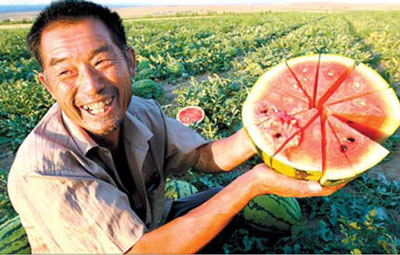The towering walls of watermelons (xi gua) that accumulate at my local fruit-seller are a sight I will forever associate with the sticky Beijing summer.
Coming from UK, a country that does not grow, nor particularly consume the fruit, I was baffled that they could be scoffed in sufficient quantities to support such stockpiles. I soon learned that multiple gluttonous chunks of crisp, succulent watermelon are the perfect thirst quencher and antidote to the oppressive heat.
The cultivation of watermelons in China began before AD 10, and unsurprisingly China is now the largest producer of watermelons in the world, with around one third of its production coming from the counties surrounding Beijing.
In celebration of this, Beijing holds its own annual watermelon festival at the end of May in Daxing county.
Daxing is also home to wait for it the country's only watermelon museum, which apparently boasts more than 170 species of the fruit!

A famer shows off a fresh watermelon in a suburb of Beijing. (photo:China Daily)
As with most fruits in China, watermelon is simply served in wedges as a snack or to finish off a meal. Watermelon juice, which is extremely refreshing, is also a popular drink in Western and Chinese restaurants.
Xi gua lao (watermelon jelly) is a traditional Beijing dish, and one of a few to use watermelon as an ingredient. It is made by boiling sugar and jelly with water and then mixing in sliced cherries and watermelon juice. This is then chilled before serving.
At home, in addition to whipping up countless variations of watermelon smoothies, I like to toss a bit of watermelon into the odd salad. My favorite combination is hunks of watermelon and tomato, dressed with red wine vinegar and topped with crumbled feta cheese, torn mint leaves and toasted flaked almonds.
It may come as no surprise to learn that water melon is made up primarily of water, making it excellent for hydration. It also is very low in calories, with one cup of watermelon supplying around 46 kcal.
Although fairly low in minerals and vitamins, watermelons contain especially high levels of lycopene which, in addition to being a precursor to vitamin A, is a particularly powerful anti-oxidant that has been associated with decreasing cancer risks, especially prostate cancer in men.
The white rind of the watermelon (not the skin) is also consumed in China both in stir-fries and in preserves.
To my mind, chutney seems a brilliant way to make use of this otherwise discarded food. Place six cups of the cubed rind in a pan with one and a half cups of cider vinegar, one and a half cups of water, two cups of sugar, four tablespoons of minced ginger, one and a half tablespoons of minced garlic and a few crushed black pepper corns. Bring to a boil, then simmer until the rinds become clear (around 40-50 minutes). Allow to cool and store in airtight containers in the fridge.
The rind in fact contains especially large amounts of an amino acid called citrulline which is converted into arginine in the body. Arginine indirectly helps to relax blood vessels and so can reduce risks of high blood pressure and cardiovascular disease.
Yet another part of the fruit which is consumed are the seeds - a very popular snack in China. The knack of splitting the shell to get at the seed in an efficient manner is an acquired talent, and some ardent consumers develop tell-tale grooves in their in incisor teeth as a result of their years of practice.
The seeds are a good source of protein, polyunsaturated fats and minerals, especially magnesium and iron.
This nutrition-related column is written by Nina Lenton, a qualified dietitian living and working in Beijing. Contact her at nina_lenton@hotmail.com.
(China DailyJuly 16, 2008)